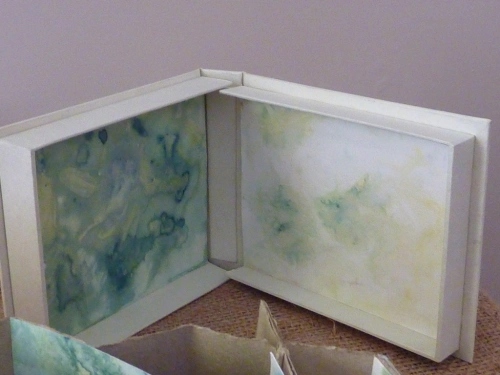…by looking back! Small wonder the god Janus is conceived as two-faced: with one face that looks back, the other that looks forward. So to look forward, I start from the experience of my 2013 Pilgrimage of Life In Art.
My pinched nerve and rotator cuff injury in early December 2013 has forced quite a few changes of plan, art-wise, for the early winter of 2014. So without 2014 work to show you just yet, for the next while I will present some images and info about my pre-2014 work, some of which has not so far made it to these pages, plus the work of some other fave artists.
My other intention, looking forward, is to update other pages on this blog, especially the info about native dye plants and links to other artists who work with bioregional plants for contact printing, wherever they might live in the world. That will indicate to you the focus of my art direction in 2014! I am looking forward to planning a new native/bioregional/pioneer plant dye garden in my new abode this summer.
Meantime, may I show you some pics of some of my 2013 Artist Books in their clamshell cases, the latter made by my husband, Shlomo? We are both members of the Canadian Book Binders and Book Artists Guild. Our chapter, the Ottawa Valley, has an exhibit of members' Artist Books at the University of Ottawa Morriset Library for a month, starting January 13. The photos of the books were taken in last summer:
Rust and maple prints:
Now this is not an Artist Book, nor do I have his permission to show the work since the unnamed artist died several centuries ago. But the image shows inspiration for my Italian eco prints and eco dyes: Umbrian frescos, decayed over time.
Below is a collection of contact prints on paper and textiles made with blue iris, part of my summer 2013 project to discover the pigment potential in blue iris blooms and the handmade paper potential of iris leaves. These works were exhibited at Portage du Fort, Quebec, as exemplars of Renaissance artist pigments and part of the Samuel de Champlain explorer festival. The display at Portage du Fort was later set up at the Ottawa School of Art. The photo shows a printed silk panel, several iris prints on paper and Artist Books of various structures including pages made with iris leaf paper, printed with iris pigment and iris ink. Clamshell case by Shlomo, papers by Wendy:
My artist residency work in Assisi:
More of my paper and textile fresco work, this time at the public gallery of the City of Assisi in the historic Piazza Commune. The photo shows a group exhibit of work by artists in residence 2013 at Arte Studio Ginestrelle, Assisi, Umbria:
One of my Artist Books shown at the University of Ottawa this month:
And the next series of beautiful glass mosaics was made by my daughter, Sarah, using a box of leftover glass fragments given to her by Shlomo. She took a pair of glass doors in her house and fitted the panes with glass mosaic:
Here is a work by another of my fave artists, my grandson, Dylan, now aged 4.
And a final work by an unknown artist's hand, found at the flea market in Gubbio where Saint Francis tamed the wolf: showing Assisi work, though in a less popular colour, pink. Note the beautiful damask linen weave typical of linen handtowels in that region. It is wonderful to think that once, time spent on work like this was considered time well spent:
Until the next Look Forward!
Happy new year to all my readers and a special thank you to all who have subscribed as followers.
Wendy






























































































